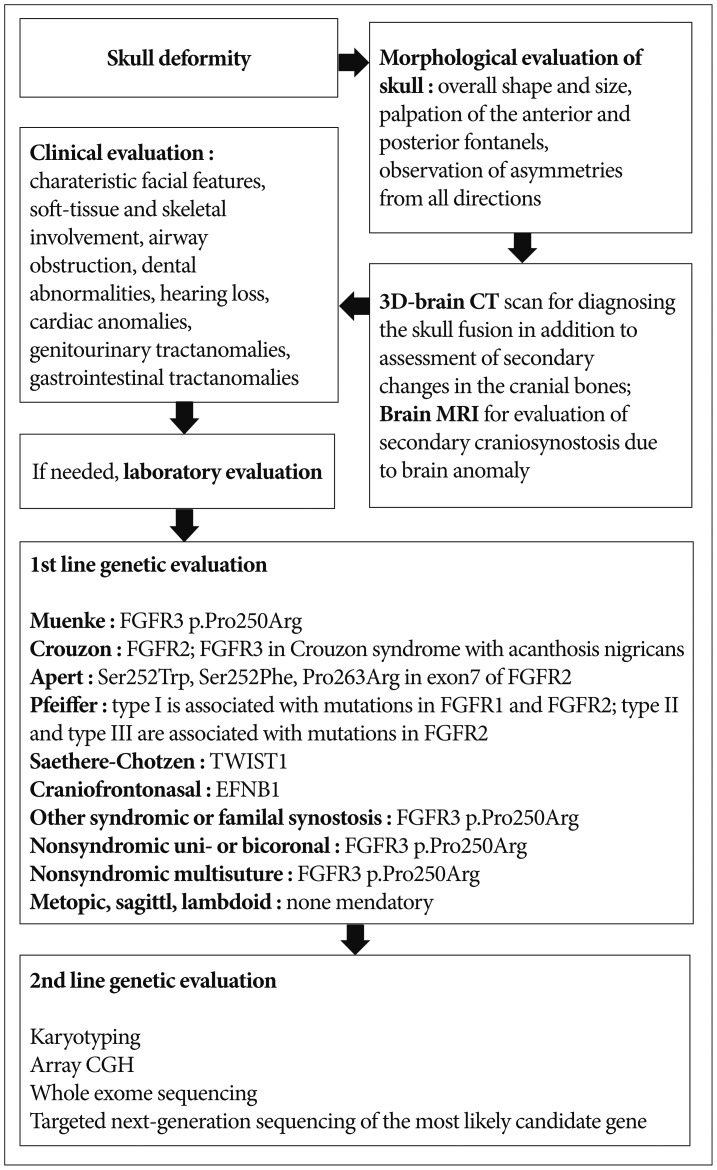J Korean Neurosurg Soc.
2016 May;59(3):214-218. 10.3340/jkns.2016.59.3.214.
Update of Diagnostic Evaluation of Craniosynostosis with a Focus on Pediatric Systematic Evaluation and Genetic Studies
- Affiliations
-
- 1Department of Pediatrics, Kyungpook National University Hospital, Daegu, Korea.
- 2Department of Neurosurgery, Kyungpook National University Hospital, Daegu, Korea. shwang@knu.ac.kr
- KMID: 2192089
- DOI: http://doi.org/10.3340/jkns.2016.59.3.214
Abstract
- Most craniosynostoses are sporadic, but may have an underlying genetic basis. Secondary and syndromic craniosynostosis accompanies various systemic diseases or associated anomalies. Early detection of an associated disease may facilitate the interdisciplinary management of patients and improve outcomes. For that reason, systematic evaluation of craniosynostosis is mandatory. The authors reviewed systematic evaluation of craniosynostosis with an emphasis on genetic analysis.
Keyword
MeSH Terms
Figure
Reference
-
1. Boulet SL, Rasmussen SA, Honein MA. A population-based study of craniosynostosis in metropolitan Atlanta, 1989-2003. Am J Med Genet A. 2008; 146A:984–991. PMID: 18344207.
Article2. Boyadjiev SA. International Craniosynostosis Consortium. Genetic analysis of non-syndromic craniosynostosis. Orthod Craniofac Res. 2007; 10:129–137. PMID: 17651129.
Article3. Chinen Y, Kaname T, Yanagi K, Saito N, Naritomi K, Ohta T. Opitz trigonocephaly C syndrome in a boy with a de novo balanced reciprocal translocation t(3;18)(q13.13;q12.1). Am J Med Genet A. 2006; 140:1655–1657. PMID: 16835930.
Article4. Eshel G, Lahat E, Reish O, Barr J. Neurodevelopmental and behavioral abnormalities associated with deletion of chromosome 9p. J Child Neurol. 2002; 17:50–51. PMID: 11913572.
Article5. Forbes BJ. Congenital craniofacial anomalies. Curr Opin Ophthalmol. 2010; 21:367–374. PMID: 20634697.
Article6. Hehr U. Molecular genetic testing of patients with craniosynostosis. In : Muenke M, Kress W, Collmann H, Solomon BD, editors. Craniosynostoses: molecular genetics, principles of diagnosis and treatment. Basel: Karger;2011. Vol 19:p. 177–183.7. Hukki J, Saarinen P, Kangasniemi M. Single suture craniosynostosis: diagnosis and imaging. In : Rice DP, editor. Craniofacial sutures: development, disease and treatment. Basel: Karger;2008. Vol 12:p. 79–90.8. Johnson D, Wilkie AO. Craniosynostosis. Eur J Hum Genet. 2011; 19:369–376. PMID: 21248745.
Article9. Kariminejad A, Kariminejad R, Tzschach A, Ullmann R, Ahmed A, Asghari-Roodsari A, et al. Craniosynostosis in a patient with 2q37.3 deletion 5q34 duplication: association of extra copy of MSX2 with craniosynostosis. Am J Med Genet A. 2009; 149A:1544–1549. PMID: 19533795.10. Khanna PC, Thapa MM, Iyer RS, Prasad SS. Pictorial essay: the many faces of craniosynostosis. Indian J Radiol Imaging. 2011; 21:49–56. PMID: 21431034.
Article11. Lajeunie E, Le Merrer M, Bonaïti-Pellie C, Marchac D, Renier D. Genetic study of nonsyndromic coronal craniosynostosis. Am J Med Genet. 1995; 55:500–504. PMID: 7762595.
Article12. Mefford HC, Shafer N, Antonacci F, Tsai JM, Park SS, Hing AV, et al. Copy number variation analysis in single-suture craniosynostosis : multiple rare variants including RUNX2 duplication in two cousins with metopic craniosynostosis. Am J Med Genet A. 2010; 152A:2203–2210. PMID: 20683987.13. Merrill AE, Bochukova EG, Brugger SM, Ishii M, Pilz DT, Wall SA, et al. Cell mixing at a neural crest-mesoderm boundary and deficient ephrin-Eph signaling in the pathogenesis of craniosynostosis. Hum Mol Genet. 2006; 15:1319–1328. PMID: 16540516.
Article14. Panchal J, Uttchin V. Management of craniosynostosis. Plast Reconstr Surg. 2003; 111:2032–2048. quiz 2049. PMID: 12711969.
Article15. Panigrahi I. Craniosynostosis genetics: the mystery unfolds. Indian J Hum Genet. 2011; 17:48–53. PMID: 22090712.
Article16. Passos-Bueno MR, Fanganiello RD, Jehee FS. Craniosynostosis and chromosomal alterations. In : Muenke M, Kress W, Collmann H, Solomon BD, editors. Craniosynostoses : molecular genetics, principles of diagnosis and treatment. Basel: Karger;2011. Vol 19:p. 152–164.17. Raybaud C, Di Rocco C. Brain malformation in syndromic craniosynostoses, a primary disorder of white matter: a review. Childs Nerv Syst. 2007; 23:1379–1388. PMID: 17882438.
Article18. Renier D, Sainte-Rose C, Marchac D, Hirsch JF. Intracranial pressure in craniostenosis. J Neurosurg. 1982; 57:370–377. PMID: 7097333.
Article19. Robin NH, Falk MJ, Haldeman-Englert CR. FGFR-related craniosynostosis syndromes. In : Pagon RA, Adam MP, Ardinger HH, Wallace SE, Amemiya A, Bean LJH, editors. GeneReviews® [Internet]. Seattle, WA: University of Washington;1993-2016.20. Sanchez-Lara PA, Graham JM Jr. Congenital anomalies of the skull. In : Swaiman KF, Ashwal S, Ferriero DM, Schor NF, editors. Swaiman's pediatric neurology : principles and practice. ed 5. New York: Elsevier Saunders;2012. p. 247–262.
- Full Text Links
- Actions
-
Cited
- CITED
-
- Close
- Share
- Similar articles
-
- Genetic Syndromes Associated with Craniosynostosis
- The management of perioperative pain in craniosynostosis repair: a systematic literature review of the current practices and guidelines for the future
- The Unnecessity of Positron Emission Tomography Computed Tomography in the Etiologic Evaluation of Neurodevelopmental Delay in Craniosynostosis Patients
- Current and Future Perspectives in Craniosynostosis
- Diagnostic Approach in Floppy Infants


